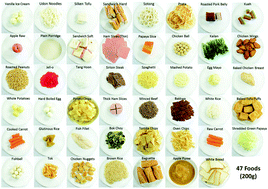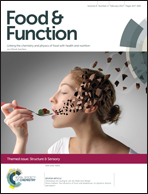Fast or slow-foods? Describing natural variations in oral processing characteristics across a wide range of Asian foods†
Abstract
The structural properties of foods have a functional role to play in oral processing behaviours and sensory perception, and also impact on meal size and the experience of fullness. This study adopted a new approach by using behavioural coding analysis of eating behaviours to explore how a range of food textures manifest as the microstructural properties of eating and expectations of fullness. A selection of 47 Asian foods were served in fixed quantities to a panel of participants (N = 12) and their eating behaviours were captured via web-camera recordings. Behavioural coding analysis was completed on the recordings to extract total bites, chews and swallows and cumulative time of the food spent in the mouth. From these measurements a series of microstructural properties including average bite size (g), chews per bite, oro-sensory exposure time (seconds) and average eating rate (g min−1) were derived per food. The sensory and macronutrient properties of each food were correlated with the microstructure of eating to compare the differences in eating behaviour on a gram for gram basis. There were strong relationships between the perceived food textural properties and its eating behaviours and a food's total water content was the best predictor of its eating rate. Foods that were eaten at a slower eating rate, with smaller bites and more chews per bite were rated as higher in the expected fullness. These relationships are important as oral processing behaviours and beliefs about the potential satiating value of food influence portion decisions and moderate meal size. These data support the idea that naturally occurring differences in the food structure and texture could be used to design meals that slow the rate of eating and maximise fullness.

- This article is part of the themed collection: Structure & Sensory

 Please wait while we load your content...
Please wait while we load your content...